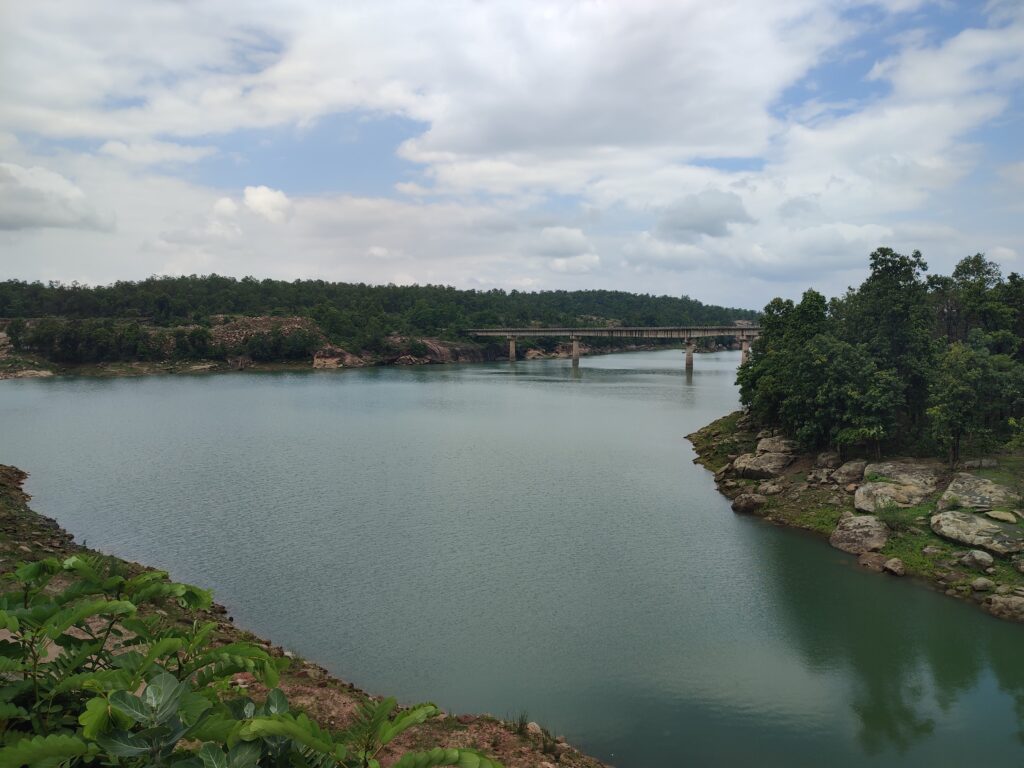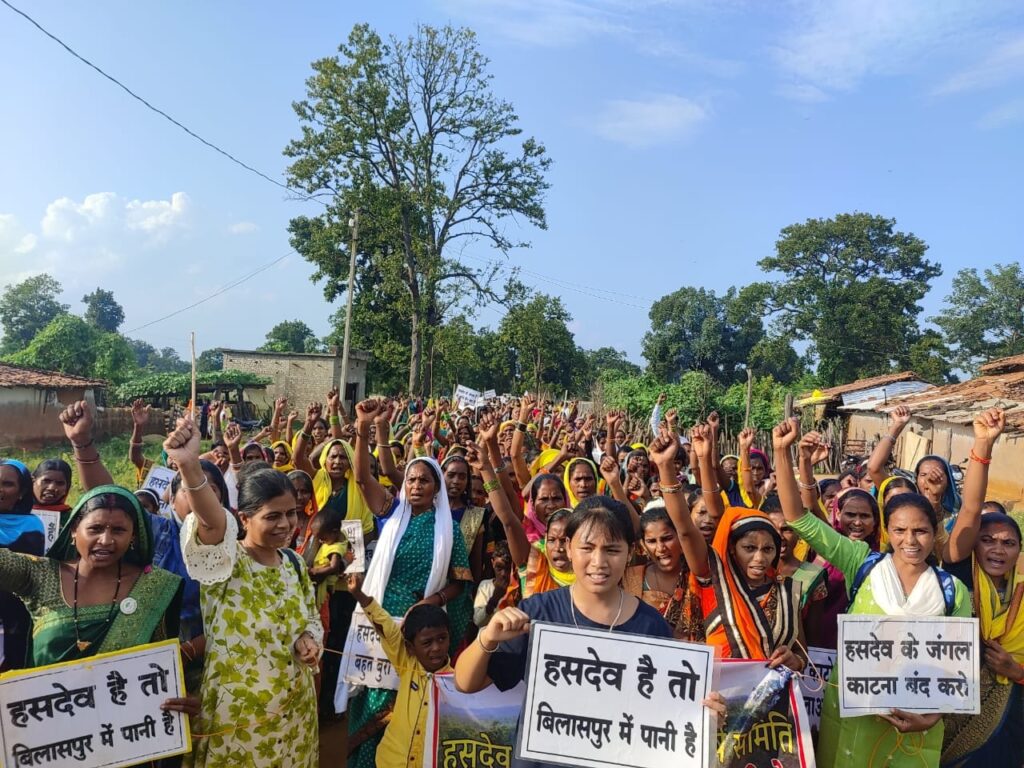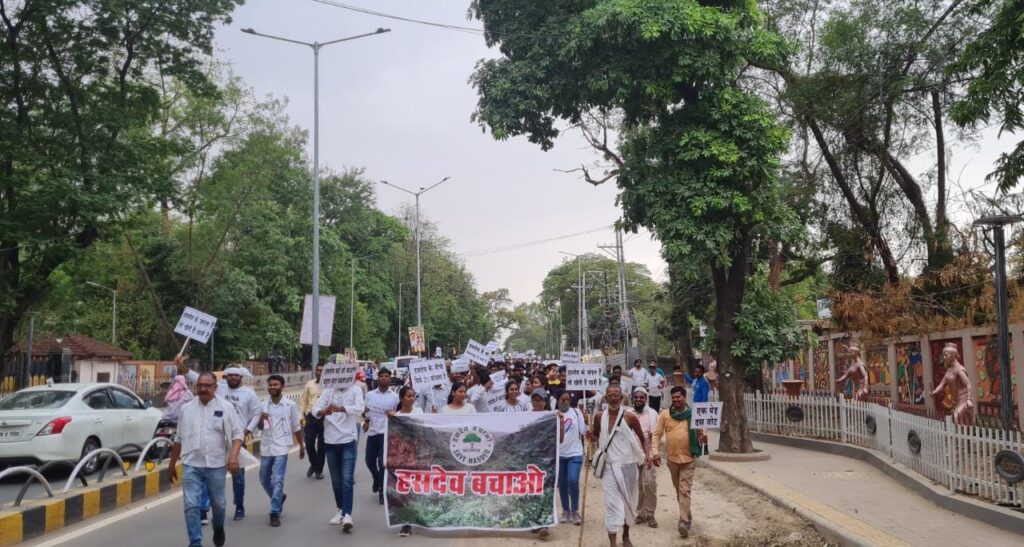The forests of Hasdeo are called the lungs of India’s Chhattisgarh state. Stretching across 3000 km², they provide a home to rich biodiversity as well as a large indigenous population. The Hasdeo forests are home to 82 species of birds as well as many threatened plant and butterfly species. These forests create an eastern link to the Satpura Maikal Tiger Landscape, connecting the Palamu tiger reserve in Jharkhand to Bandhavgarh and Achanakmar tiger reserves. They are also a major migratory corridor for elephants, and encompass the area of the proposed Lemru elephant reserve. Its human inhabitants, about 10,000 people from the Gond, Lohar, Oraon and other indigenous communities depend on these forests for their survival. The Indian Council of Forestry Research and Education has referred to Hasdeo as “the largest unfragmented forest in Central India consisting of pristine sal and teak forests.” No surprise therefore, that forest-based resources comprise 60–70% of the annual income of indigenous communities, on which they have depended for centuries.
Sadly for its inhabitants, Hasdeo grows atop a huge coalfield. The Chhattisgarh government decided to start mining the coalfields back in 2010 by converting almost 1900 hectares of forest into the Parsa East and Kete Basan (PEKB) coal mine. Fast forward to thirteen years later, local villagers, citizens of nearby cities, environmental organisations and activists have been protesting tirelessly against the total destruction of the natural ecosystem of Hasdeo. They are not only standing up against the state government of Chhattisgarh and the central government of India, but also against the biggest Indian mining conglomerate operated by one of the wealthiest people in the world.
We arrive in the city of Bilaspur in Chhattisgarh, to meet some of the key people behind the ‘Save Hasdeo’ movement. Even though we often hear that we must urgently transition from fossil fuels to renewables, being in the coal hotspot of India reminds us that the reality is vastly different. We are eager to find out how the determination of simple citizens matches up against big and powerful players exploiting the planet’s natural resources. What can we learn from the thirteen-year-long fight to save Hasdeo?
The first coal mine and following controversies
With Shreyansh Budhia and Chandra Pradeep from the Save Hasdeo movement, we visit the Parsa East and Kete Basan (PEKB) coal mine. This mine opened about 10 years ago, and for Phase I, about 760 hectares of forests were cleared for mining. Though the forest sits atop an estimated 5,000 million tonnes of coal, Parsa East and Kanta Basan is only the second coal mine in the region. What makes mining coal in this region so attractive is that coal deposits here lie only about 10 metres below the surface, which makes mining them cheap.



The Phase I of the Parsa East and Kanta Basan (PEKB) coal mine is completed. Now, the area of the mine will stand abandoned and unrecognisable to those inhabitants, who knew the forest that stood here before.
Through a specific system in India, the PEKB coal mine is actually operated by a state-owned power utility in Rajasthan and the mined coal is being sent to Rajasthan on the very western side of India, majorly driving up transportation costs. So while the firm that uses the coal to generate electricity is a state owned utility company, the operations of the mine are outsourced to the Adani Group, owned by Gautam Adani, one of the wealthiest men on the planet, and an Indian conglomerate specialising in everything from fossil fuels to construction of airports. Therefore, while citizens of Rajasthan have to pay extra for power generated by coal mined from Hasdeo due to added transportation costs, it is cheaper for the Adani Group to sell it over to the state utility company considering reduced mining costs. This, on top of the fact that mine operators like Adani have been selling low quality coal, produced after washing raw coal, to three of their own power plants for prices much below the market rate – rather than sending them to Rajasthan – has caused a huge controversy.
Although it was initially estimated that the 137 million tonnes of coal in Phase I will last 15 years, the rate of mining increased from 10 million tonnes a year to 15 million tonnes a year, depleting the mine some 7 years earlier than predicted or legally allowed. While we are looking over the depleted mine, protesters tell us that the Adani Group only mined 3 out of 6 layers of coal so far. But instead of digging deeper to mine the remaining three layers, they are cutting down more forest to expand the mine horizontally, choosing the cheaper way forward.
The central government predicts that this expansion, named Phase II, which will require clearing an additional 1,100 hectares of the forest, will be enough for 20 more years of mining. Forest clearance permissions were already given last year for 113 ha, out of which 45 ha were quickly cleared the same year. At the moment, mining is halted as the Supreme Court is examining the case.
Coal blocks up for nationwide auction
Aside PEKB, altogether 23 such coal ‘blocks’ have been identified in the Hasdeo forest by the Indian government. When we look at the size of the current PEKB mine and picture that these coal blocks are many times the size of this gigantic hole, it is impossible to imagine the destruction that their mining will cause. To nobody’s surprise, India’s biggest private power generator and coal miner, the Adani Group, quickly came on board to exploit them as well. The about 5 billion tonnes of coal that lie beneath the forests have become a huge point of interest, not only for the Adani Group, but also for other public and private mining companies from different states across the country.
There is an official auction process for the 23 coal blocks, 13 of which were already auctioned off to public mine operators from various states, such as Chhattisgarh, Rajasthan, and Gujarat, which have later been lent over to private companies for mining. Some other blocks have not yet been auctioned off but already have a forest clearance permission, therefore making it easier for the potential mine operators to start mining immediately. In the meantime, the central government recently identified 9 new mine blocks within Hasdeo. Luckily, the state government of Chhattisgarh, after being pressurised from indigenous and public protests, realised the consequences of destruction, and has requested the central government that the opening of new blocks should be stopped.
Environmental impacts of large-scale mining
Back in 2011, when the mining started, villagers immediately experienced the predicted negative impacts. As mining disturbed the resident elephants and their migratory corridors, locals started encountering more rogue elephants on fields leading to increased fatalities for both humans as well as elephants. Elephants entering village settlements, destroying people’s homes, and ruining people’s crops became a common occurrence. The consequences of mining, however, were not limited to elephants. According to locals, dynamites were regularly blasted to assist with mining operations which indiscriminately damaged people’s homes and local infrastructure. The deafening sound made by blasts not only disturbed local wildlife, but became a constant nuisance and a noise pollution hazard for people. Groundwater levels went down, and with it, a culture of collectively collecting water from public wells every morning went extinct.
Environmental reports point out that the damage is irreversible. Over 40 mammal species are and will be increasingly harmed, human-wildlife conflict increases due to shrinking wildlife habitats, and the Hasdeo river is polluted as well as hydrologically impacted, compromising irrigation. The central part of India is historically known for its wild elephant population, and according to government sources, it holds 10% of India’s 27,000 wild elephants. In 2008, an elephant reserve of 3600 km² was proposed in this area. However, the size of the reserve was eventually reduced to 1600 km² to exclude the Hasdeo coal fields. This is completely nonsense, as elephants cannot be confined to one region considering their migratory instinct – a single elephant can easily cover over 3000 km² in a few months.

Due to the coal mines, the Hasdeo river is polluted as well as hydrologically impacted, at the same time compromising irrigation.
Indian laws require that when forest land is destroyed for a project, new saplings are to be planted over twice as much area elsewhere, which is called ‘compensatory reforestation’. However, destroying an intact, old-growth forest ecosystem cannot be evened out by planting an even-aged plantation elsewhere. In addition, villages would have to be relocated, and thousands of people would lose their homes. Many indigenous villagers rely on the forest for food, culture, medicine, and their livelihoods. Losing the forest would result in losing their identity. Hence, Indian activists emphasise that loss of biodiversity and the displacement of Hasdeo’s indigenous population will be irreparable.
The birth of the Hasdeo movement
Protests against mining started in 2011 in villages where mining started. However, many villagers didn’t know what to do. They felt powerless and intimidated, believing that they had no choice but to follow government orders. Adani’s employees presented themselves as the good guys, handing out money, gifts and liquor to locals. Some of those people who had to leave their homes due to the mining operation received financial compensation: However, without financial education, most of them spent this amount quickly and have struggled to make a living ever since.
Eventually, protests spread to bigger cities, and reached the city of Bilaspur around 2020. In the following years, protesters organised candle marches, hunger strikes, demonstrations, even film festivals and a sit-in dharna protest that continues till date. Songs were composed and videos were made. Chandra Pradeep, who accompanies us while we visit the PEKB mine, was one of three people participating in the six-day-long hunger strike held last autumn. “In my opinion we didn’t have enough impact. Nevertheless, the health minister came and promised to join the protest if more forest gets cut, which is why we stopped the strike,” he tells us.


Participants of the Save Hasdeo movement protest against the deforestation and the destruction of the environment (photos by The Save Hasdeo – Bilaspur Protest).
Protesters explain that it is unique to see city people stand up for rural issues in India. We meet Rishi Kant Chaudhary, who holds a PhD in Economy and had a stable job teaching in a college, before he moved to a village inside Hasdeo one year ago. Since then, he has been active in the protests full-time, mainly focusing on educating the inhabitants of 16 villages about their rights according to the Forest Act of India. “This is a big challenge. People are not aware about the law, their rights and consequences of actions. They have to be made aware of the long-term impacts of such coal mines on their own lives and traditions,” adds Rishi.


Shreyansh Budhia and Chandra Pradeep from the Save Hasdeo movement discuss the current state of the protests. Rishi Kant Chaudhary has left his stable job and joined the movement to educate local villagers about their rights and the consequences of their choices.
Protests against mining have swooped through the region and even beyond. Some 10.000 people are affected on the ground, and activists across the country responded to their call. “There were protests attended by more than a thousand people. Several famous activists and even celebrities joined us in the fight,” Shreyansh Budhia tells us. In some villages as well as in Bilaspur, locals gather several times a week, sitting and chanting to convince other villagers not to sell land to Adani. Rajashree, a young villager we meet, tells us that he was 12 when mining started in 2010, and has been protesting ever since.
Small successes reach far
For Phase II of the PEKB mine, villagers already sold the necessary land, so they are not protesting against – urban protesters continue to stand against this however. Their concern is the opening of new coal blocks, affecting even more villages and their forests. Recently, the Chhattisgarh government appealed to the Indian Ministry of coal (Yes, that exists!) to withdraw nine coal blocks out of the 23 in Hasdeo from the auction for commercial mining citing environmental reasons, and finally, the Tara coal block, which has an 81% forest coverage, was successfully withdrawn from auctioning.
After so many years, finally with some backing of the state government, the long fight to save Hasdeo and stand up against huge mining conglomerates seems to bring some successes. We really hope and believe that the determination of the people involved in the Hasdeo movement might just prove the old quote “the strong do what they can and the weak suffer what they must” wrong. The locals have spoken up and expressed that they don’t want more coal mines. Instead, what they need are healthy forests that provide them with the foundations of their lives.

